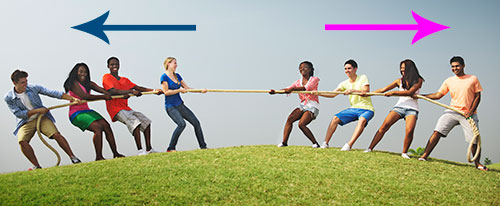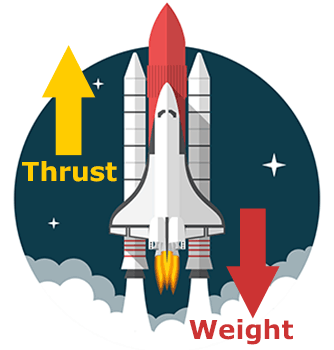Learn
Balanced and Unbalanced Forces
Balanced
There are usually multiple forces acting on an object. Think about a book sitting on a desk. What forces are acting on the book?

You may be tempted to think that there are no forces acting on the book because it is sitting still, but think again! First, what is keeping the book from simply floating into the air? Hopefully you recognize that the force of gravity is at work pulling the book down.
So, what is keeping the book from moving towards the ground because of gravity? Well, the table the book is sitting on is exerting an upwards force on the book which keeps the book from falling to the ground. The table applies the exact same force as gravity just in an opposite direction (gravity pulls down while the table pushes up). We would say that these forces are balanced.
Balanced forces are forces that are equal but in opposite directions. When forces are balanced, we tend to say there is no net force acting on an object.
The net force is the total amount of forces acting on an object added together. However, remember that force is a vector quantity, which means it has both magnitude and direction. So, when we consider net force, we must consider both magnitude and direction. With balanced forces, the net force acting on an object is 0.
Balanced forces do not cause a change in motion on an object. This means two things; an object with balanced forces is either:
- not in motion (like the book sitting on the table).
- moving at a constant velocity (no acceleration = no change in motion)

Notice in the image of tug of war above, the forces are equal and in opposite directions. The forces cancel each other; therefore the net force is zero.
Watch the video Balanced Force (2:25) to learn more. DES login information.
Unbalanced Forces
Let's think about that book sitting on the table again. Think about what happens when you take your hand and start pushing the book to the right. What happens to the book? Well, it starts to move to the right.
What does this mean? The forces on the book are no longer balanced. Now there is a net force greater than zero acting on the object, and that force is coming from your hand. We call this an unbalanced force.
Unbalanced forces occur when the net force on an object is not zero. With unbalanced forces,
- the forces can be added together or combined
- the forces can be in opposite or the same direction
In the example above, there are multiple forces push or pull acting on the book. First, there is still the force of gravity pulling down and the force from the table (referred to as the normal force) pushing up. These forces continue to be in balance. There is also the force from your hand pushing the book to the right. There is also one more force acting on the book. Can you think of it?
As you push the book to the right, friction the resistance of one object moving over/across another acts as a force against your hand. However, you easily overcome the force of friction causing an unbalanced force, which causes the book to move to the right.

A rocket blasting off into space is an example of an unbalanced force. Look at the picture above. If the thrust was providing the exact same amount of force as the weight (force of gravity) on the rocket, the rocket would just sit on the launch pad. However, since the thrust upward is a greater force than the force of gravity (weight) that the rocket moves upwards and is launched into space.
Watch the video Unbalanced Forces (2:06) to learn more. DES login information.